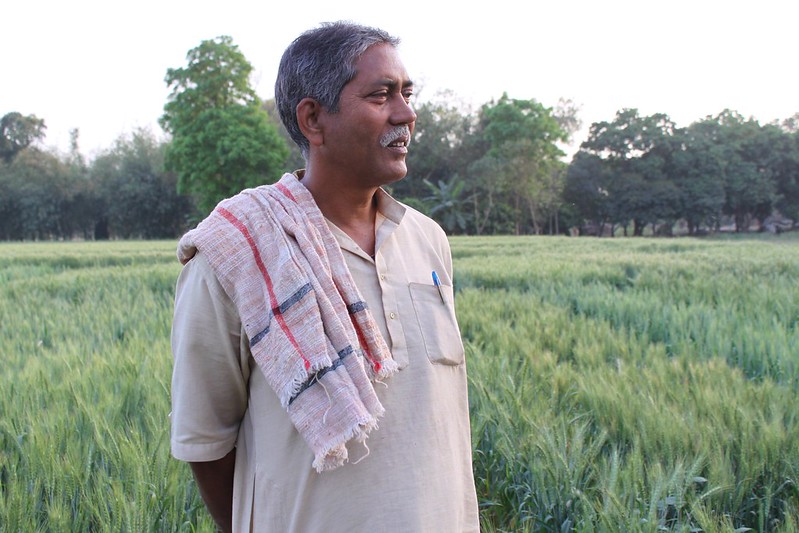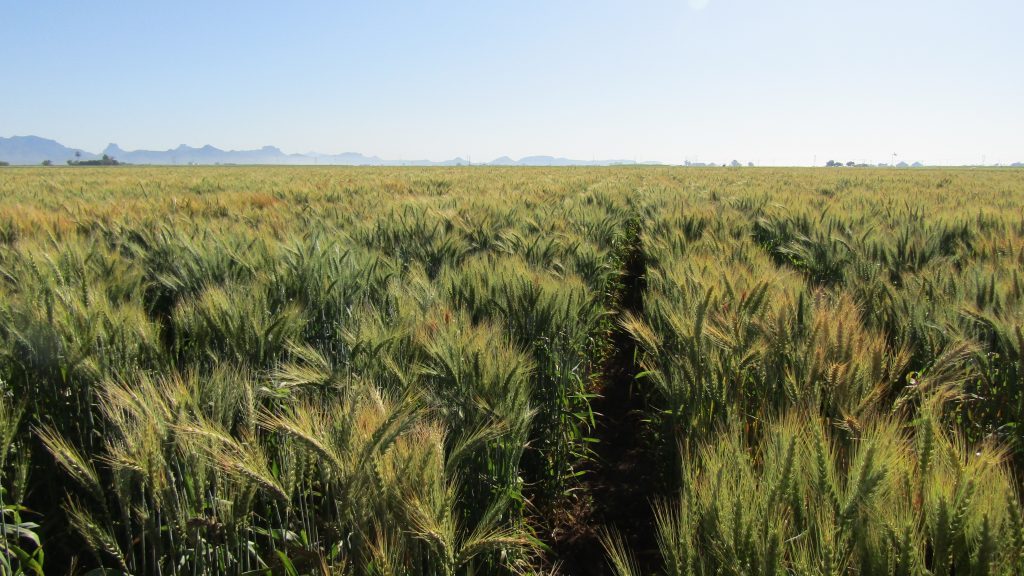November 27, 2020

Farmer Raj Narayin Singh stands in his wheat field in Bihar, India. (Photo: Petr Kosina/CIMMYT)
Since the earliest days of global wheat breeding at the International Maize and Wheat Improvement Center (CIMMYT), breeders have made their crossing selections to meet farmers’ requirements in specific environments throughout the world’s wheat-growing regions.
To streamline and make this trait selection process consistent, in the 1970s CIMMYT breeders developed 15 mega-environments — sets of farming, climatic, weather, and geographic conditions to use as profiles for testing their varieties.
They took this a step further in the 1980s by developing sets of profiles for their varieties with common characteristics in current — and projected — climatic, soil and hydrological characteristics as well as socioeconomic features such as end-use quality and agronomic practices.
In newly presented research, CIMMYT wheat scientist Leo Crespo has taken another look at these mega-environments in the form of target population of environments (TPE) — specifically the ones that fall in the bread basket wheat production area of India — to create more nuanced definitions based on updated underlying conditions and desired traits.
Using meteorological and soil data, along with information about farmers’ practices in each region and more advanced analytical methods, Crespo defined three new specific TPEs for the region:
- TPE1, in the optimally irrigated Northwestern Plain Zone with higher yield potential;
- TPE2, in the irrigated, heat-stressed Northeastern Plains Zone; and
- TPE3, in the drought-stressed Central-Peninsular Zone.
These TPEs encompass more than 28 million hectares, equivalent to more than 97% of India’s total wheat production area.
“While the mega-environments can be broad and transcontinental, we defined the TPE at a more regional level,” said Crespo. “In fact, two of our new TPEs — the NWPZ (TPE1) and part of the NEPZ (TPE2) — have distinct climate and soil characteristics, but they both fall under the same mega-environment: ME1.”

Elite wheat varieties at CIMMYT’s experimental station in Ciudad Obregon, Mexico. (Photo: Marcia MacNeil/CIMMYT)
Comparing international environments
Crespo later cross-checked these TPEs with the testing environments that CIMMYT wheat breeders use in the research station in Obregon, in Mexico’s Sonora Valley.
Obregon has long been valued by wheat breeders worldwide for its unique capacity to simulate many wheat growing conditions. Wheat grown in the various testing environments replicate in Obregon — known as selection environments (SEs) — goes through an arduous testing process including testing in other agroeconomic zones and undergoing pest and disease infestations to demonstrate its resilience.
This process, though intensive, is much cheaper and more efficient than testing each potential new wheat line in every major wheat growing area. That is why it is so important to verify that the decisions made in Obregon are the right ones for farmers in the diverse growing areas of the world.
Crespo used data from one of CIMMYT’s global wheat trials, the Elite Spring Wheat Yield Trials (ESWYT), to estimate the genetic correlation between the TPEs and in Obregon, selection response indicators and performance prediction. He found that wheat lines that perform well in the Obregon selection environments are very likely to display high performance in the TPEs he defined in India.
“Our results provide evidence that the selection environments in CIMMYT’s Obregon research station correlate with international sites, and this has led to high genetic gains in targeted regions,” explained Crespo.
“We can achieve even greater gains by targeting selections for farmers in the TPEs and improving the testing in those TPEs, along with the high-quality evaluations from the selection environment.”
These findings confirming the relationship between the selection environments and farmers’ fields in one of the world’s largest wheat growing regions allow CIMMYT to realize its mission to deliver superior wheat germplasm to national partners for their breeding programs, or for direct release as varieties for farmers throughout the world.
Watch Leo Crespo’s full presentation at the BGRI Technical Workshop.